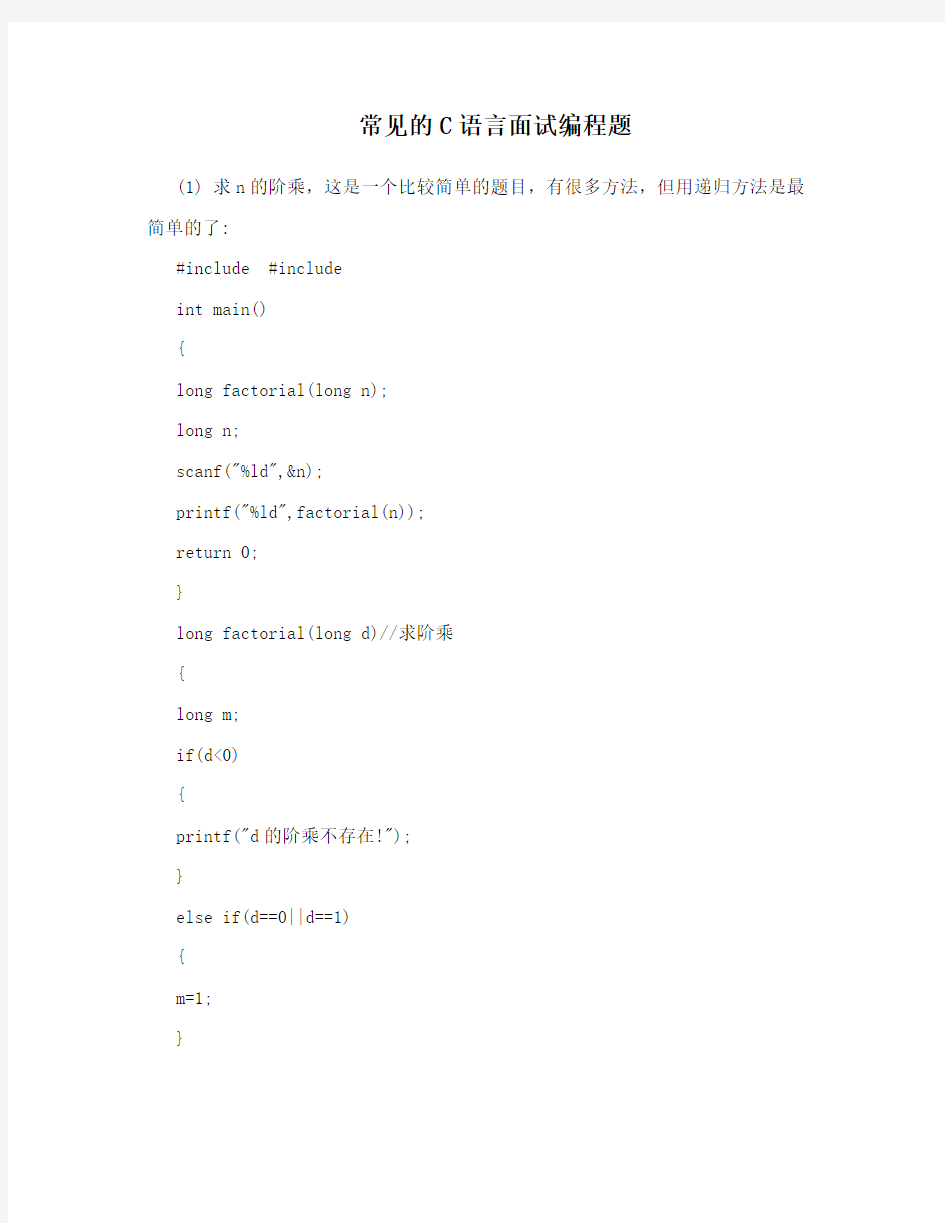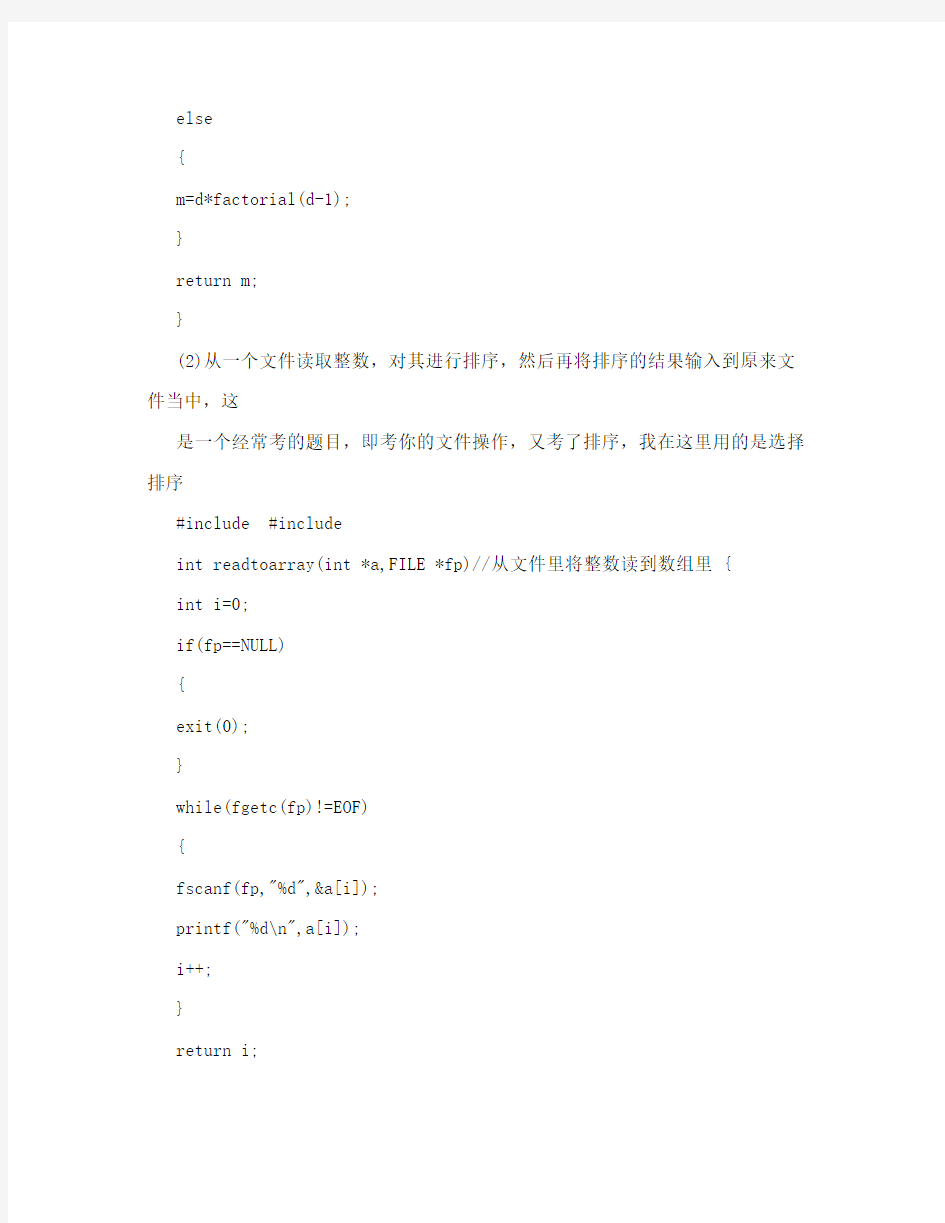常见的C语言面试编程题


常见的C语言面试编程题
(1) 求n的阶乘,这是一个比较简单的题目,有很多方法,但用递归方法是最简单的了:
#include
int main()
{
long factorial(long n);
long n;
scanf("%ld",&n);
printf("%ld",factorial(n));
return 0;
}
long factorial(long d)//求阶乘
{
long m;
if(d<0)
{
printf("d的阶乘不存在!");
}
else if(d==0||d==1)
{
m=1;
}
else
{
m=d*factorial(d-1);
}
return m;
}
(2)从一个文件读取整数,对其进行排序,然后再将排序的结果输入到原来文件当中,这
是一个经常考的题目,即考你的文件操作,又考了排序,我在这里用的是选择排序
#include
int readtoarray(int *a,FILE *fp)//从文件里将整数读到数组里 {
int i=0;
if(fp==NULL)
{
exit(0);
}
while(fgetc(fp)!=EOF)
{
fscanf(fp,"%d",&a[i]);
printf("%d\n",a[i]);
i++;
}
return i;
}
void writetofile(int a[],FILE *fp,int i)//将数组写到文件里去{
int k = 0;
if(fp==NULL)
{
exit(0);
}
while(k { fprintf(fp,"%c%d",' ',a[k++]); } } void selectionSort(int *a,int i)//选择排序 { int m,n; int tmp,min; for(m=0;m { min=m; for(n=m+1;n { if(a[n] min=n; } tmp=a[m]; a[m]=a[min]; a[min]=tmp; } } int main() { FILE* fp,* fpwrite; int i; int a[10]; fp=fopen("2.txt","r"); i=readtoarray(a,fp); fclose(fp); selectionSort(a,i); fpwrite=fopen("2.txt","w"); writetofile(a, fpwrite,i); fclose(fpwrite); return 0; } 1,单向链表的插入,删除,逆序操作#include #include typedef struct Node { int key; struct Node* next; }* node; node newNode(int k) { node n=(node)malloc(sizeof(node)); n->key=k; n->next=NULL; return n; } void printlist(node n) { if(!n) { printf("n is NULL list\n"); } while(n) { printf("%d",n->key); printf(" "); n=n->next; } printf("\n"); } node newList() { int k; node head=(node)malloc(sizeof(node));; scanf("%d",&k); if(k==0) { head=NULL; return head; } else { node n=newNode(k); head=n; while(k) { scanf("%d",&k); if(k!=0) { node n1=newNode(k); n->next=n1; n=n->next; } } n->next=NULL; return head; } } node insertNode(node n,int p,int k) { node n1=newNode(k); node head=(node)malloc(sizeof(node)); head=n; if(head==NULL) { n1->next=head; return n1; } else { if(p==1) { n1->next=head; head=n1; return head; } else { int i=2; while(i!=p&&(n->next)) { n=n->next; i++; } if(n->next==NULL) { printf("the p can't be found\n"); return head; } else { n1->next=n->next; n->next=n1; return head; } } } } node deleteNode(node n,int k) { node n1=(node)malloc(sizeof(node)); node head=(node)malloc(sizeof(node)); head=n; if(head==NULL) { printf("list is NULL\n"); return head; } else { if(head->key==k) { head=head->next; return head; } while(n->key!=k&&n->next) { n1=n; n=n->next; } if(n==NULL) { printf("can't find the same value as k in this list\n"); return head; } else { n1->next=n->next; n=NULL; return head; } } } node reverse(node n) { node n1[10]; node head=(node)malloc(sizeof(node)); node n2=(node)malloc(sizeof(node)); head=n; if(head==NULL) { return head; } else { int i=0; while(head!=NULL) { n2=head; head=head->next; n2->next=NULL; n1[i]=n2; i++; } head=n1[i-1]; for(int j=i-1;j>0;j--) { n1[j]->next=n1[j-1]; } return head; } } int main() { node n=newList(); printlist(n); //插入操作 int k,p; scanf("%d,%d",&p,&k); node nn=insertNode(n,p,k); printlist(nn); //删除操作 int q; scanf("%d",&q); node nd=deleteNode(nn,q); printlist(nd); //链表的倒置操作 node m=reverse(n); printlist(m); return 0; } 2,双向链表的插入删除操作 #include int key; struct Node* pre; struct Node* next; }* node; node newNode(int i) { node n=(node)malloc(sizeof(node)); n->key=i; n->pre=NULL; n->next=NULL; return n; } node newduplinklist() { int i; scanf("%d",&i); node n; if(i==0) { n=NULL; return n; } n=newNode(i); node head=n; int k=1; while(k!=0) { scanf("%d",&k); if(k!=0) { node n1=newNode(k); n->next=n1; n1->pre=n; n=n1; } } n->next=head; head->pre=n; return head; } int sizeduplinklist(node n) { if(n==NULL) return 0; node head=n; int i=1; while(head->next!=n) { head=head->next; i++; } return i; } void print(node n) { if(n==NULL) printf("此时链表为空!"); else { printf("输出链表:\n"); for(int i=0;i printf("%-2d",n->key); n=n->next; } printf("\n"); } } node insertNode(node n) { int p,k; printf("插入位置p:\n"); scanf("%d,%d",&p,&k); printf("\n"); if(p>sizeduplinklist(n)) { printf("此位置超出链表的长度!\n"); return n; } else if(p<1) { printf("此位置不存在!\n"); return n; } else { node n1,head,m; m=newNode(k); head=n; if(p==1) { m->pre=n->pre; n->pre->next=m; m->next=n; n->pre=m; return m; } else { int i=1; while(i!=p) { n1=n; n=n->next; i++; } n1->next=m; m->pre=n1; m->next=n; n->pre=m; return head; } } } node delNode(node n) { int p; printf("删除位置p:\n"); scanf("%d",&p); printf("\n"); if(p>sizeduplinklist(n)) { printf("此位置超出链表的长度!\n"); return n; } else if(p<1) { printf("此位置不存在!\n"); return n; } else { node n1,head; if(p==1) { head=n->next; n->pre->next=n->next; n->next->pre=n->pre; return head; } else { head=n; int i=1; while(i!=p) { n1=n; n=n->next; i++; } n1->next=n->next; n->next->pre=n1; return head; } } } int main() { node n=newduplinklist(); printf("%d\n",sizeduplinklist(n)); print(n); node m=insertNode(n); print(m); node m1=delNode(m); print(m1); return 0; } 3,栈操作,用数组实现的包含出栈,入栈的操作#include int a[20]; int num; }* sta; sta NullStack() { sta s=(sta)malloc(sizeof(sta)); s->num=0; return s; } sta pushstack(sta s,int i) { s->a[s->num]=i; s->num=s->num+1; return s; } sta popstack(sta s) { if(s->num==0) { printf("stack is NULL\n"); return s; } s->num=s->num-1; return s; } void printstack(sta s) { if(s->num==0) { printf("stack is NULL\n"); } else { for(int i=s->num-1; i>=0;i--) { printf("%d\n",s->a[i]); } } } int main() { sta s=NullStack(); s=pushstack(s,1); s=pushstack(s,2); printstack(s); s=popstack(s); s=popstack(s); printstack(s); return 0; } 4,队列操作,类似于栈, #include typedef struct Que { int a[20]; int num;
